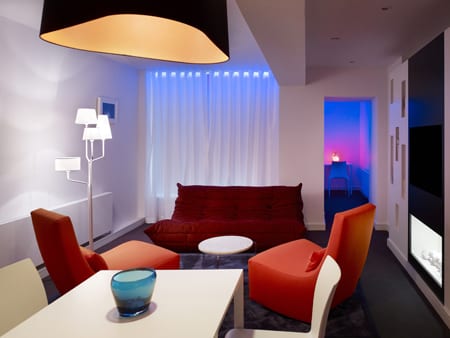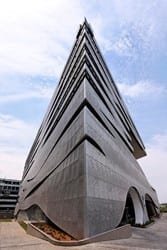 Hyderabad, India, is well-known for its pearls and bangle bracelets, as well as for its Nizams, the fabulously wealthy rulers who were themselves famous collectors of jewelry and governed for some 250 years, until India gained its independence from Great Britain in 1947.
Hyderabad, India, is well-known for its pearls and bangle bracelets, as well as for its Nizams, the fabulously wealthy rulers who were themselves famous collectors of jewelry and governed for some 250 years, until India gained its independence from Great Britain in 1947.
The city’s long jewelry tradition is the inspiration for the décor of the new Park Hyderabad, a boutique hotel operated by Apeejay Surrendra Park Hotels that opened in April.
 “Hyderabad is a city known for the jewelry-making tradition. The rulers had a legendary collection of jewelry. The city was a big jewelry-making center and still is. I wanted the hotel to reflect the jewels of Hyerdabad,” says Priya Paul, chairman of the hotel company. “I’m trying to create a modern palace using a contemporary modern space that is connected to the Indian traditions in Hyderabad in a new and different way.”
“Hyderabad is a city known for the jewelry-making tradition. The rulers had a legendary collection of jewelry. The city was a big jewelry-making center and still is. I wanted the hotel to reflect the jewels of Hyerdabad,” says Priya Paul, chairman of the hotel company. “I’m trying to create a modern palace using a contemporary modern space that is connected to the Indian traditions in Hyderabad in a new and different way.”
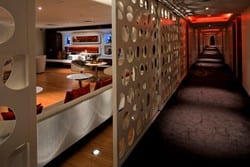 To that end, Paul assembled an eclectic, world-class, international group of architects and designers to create the hotel, each designing different sections that play off the jewelry theme. Thus, the New York office of Skidmore, Owings & Merrill-which created the building and its unique exterior, two lobbies, veranda, pool, and banqueting space-designed a building with a glass curtain wall façade that is encased in an aluminum screen whose perforated, leaf-life pattern was inspired by geometric jewelry designs. Peter Lefkovits, an associate at SOM, says that beyond its aesthetic purpose, the screen shades the building and also casts leaf-shape shadows onto its interiors.
To that end, Paul assembled an eclectic, world-class, international group of architects and designers to create the hotel, each designing different sections that play off the jewelry theme. Thus, the New York office of Skidmore, Owings & Merrill-which created the building and its unique exterior, two lobbies, veranda, pool, and banqueting space-designed a building with a glass curtain wall façade that is encased in an aluminum screen whose perforated, leaf-life pattern was inspired by geometric jewelry designs. Peter Lefkovits, an associate at SOM, says that beyond its aesthetic purpose, the screen shades the building and also casts leaf-shape shadows onto its interiors.
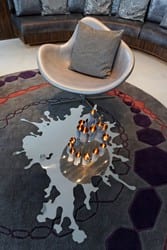 The jewel theme continues in the main third-floor lobby, where the wall behind the Macassar ebony check-in desk is silver leather, throw pillows are covered in silver sequins, and custom rugs are a silvery gray, accented by necklace-shaped pink and purple designs. SOM also created the floor’s luxurious Ruby Lounge, featuring plum velvet-upholstered banquettes, ruby pillows, and glass walls lined with antiqued gold leaf. SOM’s design for the veranda, a multi-purpose outdoor space on the third floor, includes a freeform infinity pool-with a floor of iridescent glass tiles-that is surrounded by colorful orange cabanas.
The jewel theme continues in the main third-floor lobby, where the wall behind the Macassar ebony check-in desk is silver leather, throw pillows are covered in silver sequins, and custom rugs are a silvery gray, accented by necklace-shaped pink and purple designs. SOM also created the floor’s luxurious Ruby Lounge, featuring plum velvet-upholstered banquettes, ruby pillows, and glass walls lined with antiqued gold leaf. SOM’s design for the veranda, a multi-purpose outdoor space on the third floor, includes a freeform infinity pool-with a floor of iridescent glass tiles-that is surrounded by colorful orange cabanas.
 Designed by London-based Blacksheep, the two clubs on the lower ground floor feature one large, organically shaped, off-white Corian bar sliced through by a wall of faceted, dichroic cast acrylic, which subdivides the space into the two sections, one for VIPs. Jewelry-influenced designs in the main bar include brass tables, gold leather upholstery on banquettes and stools, and a custom chandelier with opal and crystal beadwork. The rich magenta ceiling of the VIP area contains a light well that looks up into the infinity pool; sparkling mirrors adorn magenta lacquered walls.
Designed by London-based Blacksheep, the two clubs on the lower ground floor feature one large, organically shaped, off-white Corian bar sliced through by a wall of faceted, dichroic cast acrylic, which subdivides the space into the two sections, one for VIPs. Jewelry-influenced designs in the main bar include brass tables, gold leather upholstery on banquettes and stools, and a custom chandelier with opal and crystal beadwork. The rich magenta ceiling of the VIP area contains a light well that looks up into the infinity pool; sparkling mirrors adorn magenta lacquered walls.
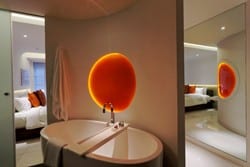 Guestrooms, by Chippendale, Australia-based Chhada Siembieda Australia, feature a minimal canvas of colors and materials chosen to best display the light and shadow play created by SOM’s aluminum screen. Walls of both guestrooms and bathrooms are white, the latter white Italian tile. These contrast with jewel-toned shades of orange, coral, ruby, emerald, peridot, and sapphire that are used in guestrooms on decorative bed pillows, upholstery on a couch, and a porthole-shaped design element, as well as on hallway walls with a punched-out, circular motif.
Guestrooms, by Chippendale, Australia-based Chhada Siembieda Australia, feature a minimal canvas of colors and materials chosen to best display the light and shadow play created by SOM’s aluminum screen. Walls of both guestrooms and bathrooms are white, the latter white Italian tile. These contrast with jewel-toned shades of orange, coral, ruby, emerald, peridot, and sapphire that are used in guestrooms on decorative bed pillows, upholstery on a couch, and a porthole-shaped design element, as well as on hallway walls with a punched-out, circular motif.
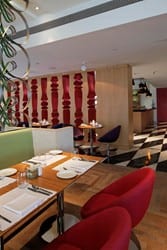 The contrarian designer among those hired by Paul is London-based Conran & Partners, whose concepts for the Verandah restaurant, adjacent to the pool, and residents’ bar deliberately steer away from the jewelry theme; these focus instead on India’s long Anglo-English tradition. Décor in the restaurant’s main dining area is inspired by Anglo-Indian formal garden design, while the residents’ bar is a contemporary take on a gentlemen’s club. Witty décor here includes yellow leather upholstery on chairs and banquettes, and a collage of antique Indian banknotes on the wall behind the polished stainless steel bar.
The contrarian designer among those hired by Paul is London-based Conran & Partners, whose concepts for the Verandah restaurant, adjacent to the pool, and residents’ bar deliberately steer away from the jewelry theme; these focus instead on India’s long Anglo-English tradition. Décor in the restaurant’s main dining area is inspired by Anglo-Indian formal garden design, while the residents’ bar is a contemporary take on a gentlemen’s club. Witty décor here includes yellow leather upholstery on chairs and banquettes, and a collage of antique Indian banknotes on the wall behind the polished stainless steel bar.

